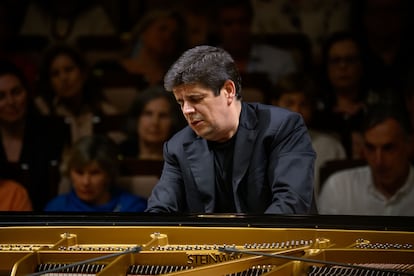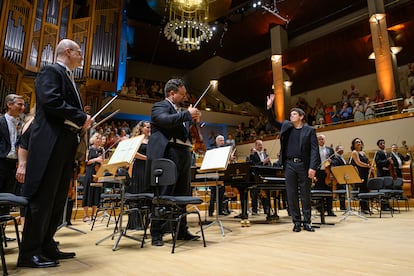Javier Perianes and Ludwig van Beethoven share their passion for musical marathons.

Ludwig van Beethoven loved musical marathons. This can be seen by reviewing the premieres of three of his piano concertos, which he played and conducted in Vienna, at large music academies held at the Burgtheater and the Theater an der Wien. The premiere of December 22, 1808, stands out, in which he premiered the following succession of masterpieces for four consecutive hours: the Pastoral Symphony , the aria "Ah! Perfido ," the Gloria from the Mass in C, and Piano Concerto No. 4 in the first part; and, in the second, he continued with the Fifth Symphony , the Sanctus from the aforementioned Mass, a piano improvisation that led to his opus 77, and the Choral Fantasy for piano, chorus, and orchestra in C minor, Op. 80 .
It would be an ideal program for one of the biannual marathons that the National Center for Musical Diffusion (CNDM) has organized since 2011 at the National Auditorium to mark Music Day, June 21. Beethoven has once again taken center stage in this seventh edition of ¡Solo Música! , just as he did in 2013. While Jesús López Cobos conducted the nine symphonies with four orchestras based in the capital (the Spanish National Orchestra, the RTVE Symphony Orchestra, the JONDE Orchestra, and the Madrid Symphony Orchestra) in the symphony hall, or several Spanish pianists played the 32 sonatas in the chamber hall, now everything has been limited to the five piano concertos over two evening sessions. But the star of the show has been Javier Perianes (Nerva, Huelva, 46), acting as soloist and conductor leading a symphony ensemble from outside Madrid that has been a revelation: the Orquestra de la Comunitat Valenciana .
The relaxed atmosphere of past editions was once again felt at the National Auditorium. As in those dedicated to Tchaikovsky in 2015 , to nine ninth symphonies from Haydn to Shostakovich in 2017 , to Russian ballets and symphonic poems by Tchaikovsky and Stravinsky in 2019 , or to the symphonies of Schumann and Brahms in 2021, in the midst of de-escalation, as there was no party in 2023. The food stalls were once again located in the foyer, where the live broadcast of Radio Clásica could be seen, and the usual giant screen was set up in the Plaza de Rodolfo y Ernesto Halffter, which attracted quite a crowd despite the heat. It all ended, as is tradition, with a fireworks display.

Perianes has years of experience and a very personal connection with these Beethovenian scores, which Jesús Ruiz Mantilla reviews today in the El País Semanal supplement . The Huelva-born pianist already played the complete Beethoven cycle at the National Auditorium in February 2019, as part of the Ibermúsica series with the London Philharmonic and Juanjo Mena, and even here he also made his debut with the Vienna Philharmonic playing the Fourth , or with the Amsterdam Concertgebouw in a last-minute substitution to play the Fifth .
The concerts were performed in the same order as in 2019, eschewing ordinal and chronological order in favor of musical coherence. The first of the two concerts featured the innovative Nos. 2, 3, and 4, the three premiered by Beethoven himself, which he played and conducted in Vienna between 1795 and 1808. The second featured more ambitious works, including No. 1, premiered by Beethoven in Prague in 1798, and No. 5, also known as the Emperor Concerto , which the composer was never able to play due to his increasing deafness and which was first heard at the Leipzig Gewandhaus in 1811.
At the beginning of the Piano Concerto No. 2, it was clear that Perianes's model for conducting from the keyboard was that of his mentor Daniel Barenboim , from whom he has received much advice. "No one has done it better than him," he commented informally after completing the feat, while acknowledging his 2007 filming at the Klavier Festival Ruhr as a reference. Obviously, Perianes is not a conductor like Barenboim, but his clear and confident gestures from the keyboard were one of the keys to the success of this musical marathon. The Spanish pianist focuses on a large-scale chamber relationship with the orchestra, but with a much more interventionist approach than other eminent colleagues such as Mitsuko Uchida, András Schiff, Leif Ove Andsnes, or Yuja Wang.

The result of No. 2 in B-flat major revealed the highly personal and interesting take on the piano composition before us. Perianes avoided the extremes of tempo and dynamics so characteristic of historicism in favor of a comfortable, clear, flexible discourse full of musical sparks. We see this in the development of the initial Allegro con brio , with that trill on the F note, which he resolved in a magical moment in pianissimo, ideally supported by the orchestra. And he chose to crown the movement with Wilhelm Kempff 's brief and apt cadenza instead of Beethoven's extended and virtuosic one. In the central Adagio , he made it clear that the idea was to sing more than to play notes, with a beautiful recitative with gran espressione that left us floating in the air. And the final Allegro molto was not lacking in its dose of playful comedy, with admirable woodwinds.
The transition to No. 3 in C minor was carried out without falsely affecting its dramatic tone, although without relinquishing the tension and harshness provided by the orchestra and managed by the piano. Perianes again flexibly and musically elevated the development of the allegro con brio , with the initial theme's wandering through various minor keys. And, this time, the cadenza was Beethoven's usual, extended and virtuoso, admirably executed. The flashes of musicality continued in the central largo , and Perianes relentlessly attacked the vigorous final rondo , producing pure chamber music with the excellent Valencian orchestra, which shone in the final transition from C minor to C major. The audience finally acknowledged him with resounding bravos.
In the second half, No. 4 in G major was the high point of the entire series. The Huelva-born pianist brings an aura of mystery to the piece from his solo opening, the Allegro moderato , but he maintains a conversation with the orchestra despite the strings of notes in the solo part. In his hands, the development shines once again, and he tells a story in the cadenza, this time opting for the longest of the three versions written by Beethoven. But the best of his performance came in the central Andante con moto , where he perfectly captured the hidden program of Orpheus in the Underworld; he managed to silence the corporeal Valencian strings while leaving the Madrid audience breathless. And he closed the work with a relentless attack on the rondo , which he transformed into another heavenly Beethovenian boutade with chamber-like sparkles.

After an intermission of less than an hour, the marathon continued with No. 1, which Beethoven composed after No. 2, although he published it first. Perianes ushered in the allegro con brio, a little slow and somewhat blurred, but everything settled into order after his entry as soloist. And, once again, the magic of Perianes's pianissimo elevated the monologue that connects with the recapitulation, where he used the shortest of the three cadenzas Beethoven wrote. In the central largo , he imposed his singing in the remote key of A-flat major and again attacked the final rondo with admirable flashes of humor, supported by another magnificent performance from the orchestra.
But No. 5 was still missing, known as the Emperor Concerto , for its length and monumental quality, both pianistic and symphonic ("The Emperor among piano concertos," in the words of editor JB Cramer). The idea of ending with the most energy-demanding work was perhaps not ideal for a marathon, even though musically it was the most logical. Perianes couldn't hide slight signs of fatigue at the start of the allegro , although he recovered as the bars passed without renouncing continuous flashes of musicality and flexibility in his handling of dynamics and tempo, qualities he once again shared with the woodwind of the Valencian orchestra. The pianist invited reflection in the Adagio in B major, and in this case, the seamless connection with the rondo was provided by Beethoven; a robust German dance to which, once again, he added doses of humor, fantasy, and insight.
It all ended well after midnight, with the audience on their feet and cheering Perianes's feat, having played and conducted all five Beethoven piano concertos from memory and at the highest level in a single evening. But the event also revealed to the Madrid audience that the best Spanish symphony orchestra is in Valencia, after attending the highest-quality edition of the CNDM festive marathons.
Beethoven: Piano Concertos 2, 3, and 4 & Piano Concertos 1 & 5. Valencian Community Orchestra. Javier Perianes (piano and conductor). National Auditorium, June 21.
EL PAÍS


